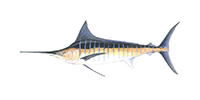Thank you for visiting the Seafood Selector. EDF is planning a new approach to providing information to consumers about good seafood choices. Please come back soon for updates.
Marlin

Striped marlin, © Amadeo Bachar
Recommended servings per month
| Contaminant | Men | Women | Kids 6-12 | Kids 0-5 | |
|---|---|---|---|---|---|
| Blue marlin | Mercury | < 1 | 0 | 0 | 0 |
| Blue marlin (imported) | Mercury | < 1 | 0 | 0 | 0 |
| Striped marlin | Mercury | < 1 | 0 | 0 | 0 |
| White marlin | Mercury | < 1 | 0 | 0 | 0 |
Eco details:
- Marlin are rarely sought by commercial fishers but often end up as unintended targets (bycatch) of tuna and swordfish longline fisheries.
- There has been little study on the abundance of marlins, but most scientists believe that all marlin species are in decline from being heavily fished and poorly managed worldwide.




